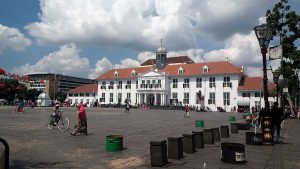If you go to almost any city in Java, you will come across a public square called an alun-alun, a large open lawn area that serves as a gathering and recreation spot. Even small towns usually have one. Jakarta, the largest of Java’s cities and Indonesia’s national capital, does not have an alun-alun. The closest thing is Monas, the national monument which sits in a large park in the city center ringed by government buildings, including the Presidential Palace.
Nowadays, this is called Merdeka Square but it used to have a different name: the Koningsplein or King’s Square. The square was built by the Dutch in the early 19th century as they pushed inland to escape the malarial vapors of Batavia’s Old Town. Many of the buildings around Merdeka Square, those that haven’t been demolished to make way for parking lots or high-rise buildings, were built by Europeans to house their social clubs and families. This includes the Presidential Palace, which before it was repurposed as the seat of the president of Indonesia is the place from which the Dutch governor-general exercised control over the colony.
Cities come into existence for many reasons and are shaped by myriad forces over time, but when we try to understand modern urban landscapes one of the most important questions to ask is: who was this city built for? In Jakarta one of the reasons there is no alun-alun is because much of the city’s footprint was laid out by foreigners to suit their tastes and needs. It was a city built to serve the commercial interests of a foreign power and many, though not all, of its modern urban problems partially stem from that.
The Dutch East India Company (VOC) first laid down roots in the area we now call Kota Tua or Old Town. This is where you find the old Town Hall, the Stadhuis, built in the early 18th century and which is now the Jakarta History Museum. The Stadhuis was not a public forum where the civic authorities carried out municipal governance in dialogue with the local population. It was a symbol and a tool of mercantilist oppression, where the commercial interests of the VOC were championed and protected. In Batavia’s early days, the Stadhuis was inside a stone-walled fort and locals – Sundanese, Betawi, Javanese – were barred from living inside the walls.
Most Europeans eventually relocated from Old Town down to the area around the Koningsplein, called Weltevreden. They would often commute to their businesses in Old Town along a grand canal linking the two parts of the city. Locals were of course not a part of this plan either. Neither Old Town nor Weltevreden were built for them or with them in mind and they simply filled in the spaces around the European residential and commercial areas in increasingly dense and unplanned kampung settlements.
This basic pattern has been replicated over and over throughout the history of Jakarta’s urban expansion, with well-heeled residents moving further and further afield to live in insular private housing developments detached from the urban core, commuting to and from work along increasingly crowded expressways. Meanwhile, just as in colonial times, the areas between these upscale commercial and residential developments have been filled in by largely unplanned and unregulated urban densification, a process academic Abidin Kusno has described as “leapfrog development.”
What this has done is created a city of immense diversity and overlap, with millions of people living on top of one another in largely unplanned sprawl that creates all sorts of traffic, flooding, and environmental problems, while replicating many inequalities from the colonial era. This is one of the driving forces behind relocating the capital away from Jakarta. Doing so will be a chance to start fresh, with a capital city built by Indonesians for Indonesians.
There is no guarantee that this time it will be different, of course. Investors are already getting cold feet, and cost is going to be an issue. The money could just as well be spent making Jakarta more livable. And the new capital city might not be any more accommodating for urban poor than the last one, assuming anyone even shows up to live there. It’s a huge gamble to move the capital to a more inaccessible part of the archipelago when Jakarta already sits at its commercial epicenter – although moving to a less Java-centric location is itself part of the logic at play here.
There are also echoes of old colonial patterns in relocating the capital to greener pastures when the challenges of urban governance become too great, just as Batavia’s Old Town was abandoned for the cleaner air of the Koningsplein two centuries ago. The difference, at least in the minds of those championing the project, is that the new city will represent from the ground up an Indonesian vision of the country and its future, free from colonial legacies. And while we might not agree with this, looking into Jakarta’s past at least allows us to grapple with some of the historical impulses behind it.

































